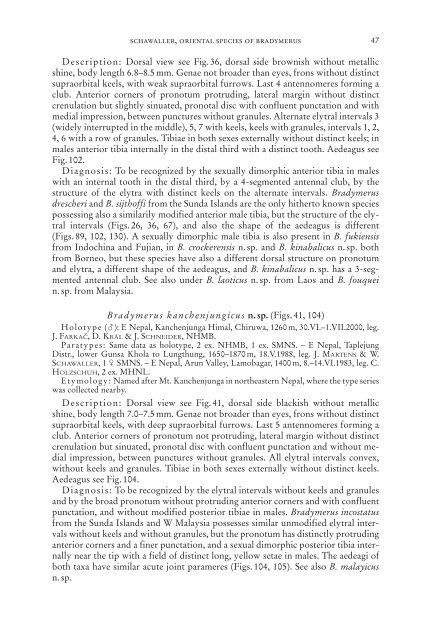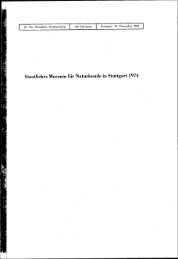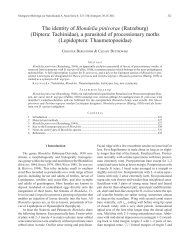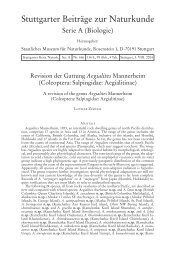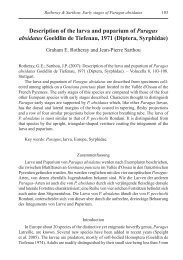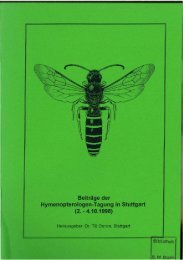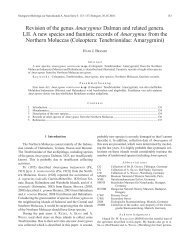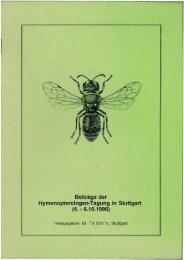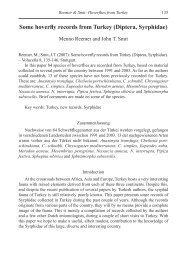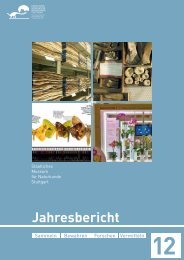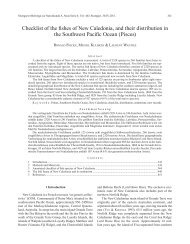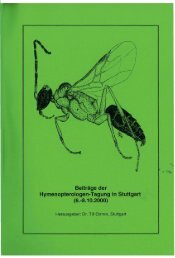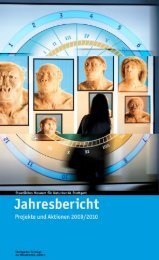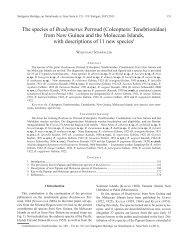Serie A (Biologie) - Staatliches Museum für Naturkunde Stuttgart
Serie A (Biologie) - Staatliches Museum für Naturkunde Stuttgart
Serie A (Biologie) - Staatliches Museum für Naturkunde Stuttgart
Create successful ePaper yourself
Turn your PDF publications into a flip-book with our unique Google optimized e-Paper software.
schawaller, oriental species of bradymerus 47Description: Dorsal view see Fig. 36, dorsal side brownish without metallicshine, body length 6.8–8.5 mm. Genae not broader than eyes, frons without distinctsupraorbital keels, with weak supraorbital furrows. Last 4 antennomeres forming aclub. Anterior corners of pronotum protruding, lateral margin without distinctcrenulation but slightly sinuated, pronotal disc with confluent punctation and withmedial impression, between punctures without granules. Alternate elytral intervals 3(widely interrupted in the middle), 5, 7 with keels, keels with granules, intervals 1, 2,4, 6 with a row of granules. Tibiae in both sexes externally without distinct keels; inmales anterior tibia internally in the distal third with a distinct tooth. Aedeagus seeFig. 102.Diagnosis: To be recognized by the sexually dimorphic anterior tibia in maleswith an internal tooth in the distal third, by a 4-segmented antennal club, by thestructure of the elytra with distinct keels on the alternate intervals. Bradymerusdrescheri and B. sijthoffi from the Sunda Islands are the only hitherto known speciespossessing also a similarily modified anterior male tibia, but the structure of the elytralintervals (Figs. 26, 36, 67), and also the shape of the aedeagus is different(Figs. 89, 102, 130). A sexually dimorphic male tibia is also present in B. fukiensisfrom Indochina and Fujian, in B. crockerensis n. sp. and B. kinabalicus n. sp. bothfrom Borneo, but these species have also a different dorsal structure on pronotumand elytra, a different shape of the aedeagus, and B. kinabalicus n. sp. has a 3-segmentedantennal club. See also under B. laoticus n. sp. from Laos and B. fouquein. sp. from Malaysia.Bradymerus kanchenjungicus n. sp. (Figs. 41, 104)Holotype (): E Nepal, Kanchenjunga Himal, Chiruwa, 1260 m, 30.VI.–1.VII.2000, leg.J. FARKAČ, D. KRÁL & J. SCHNEIDER, NHMB.Paratypes: Same data as holotype, 2 ex. NHMB, 1 ex. SMNS. – E Nepal, TaplejungDistr., lower Gunsa Khola to Lungthung, 1650–1870 m, 18.V.1988, leg. J. MARTENS & W.SCHAWALLER, 1 SMNS. – E Nepal, Arun Valley, Lamobagar, 1400 m, 8.–14.VI.1983, leg. C.HOLZSCHUH, 2 ex. MHNL.Etymology: Named after Mt. Kanchenjunga in northeastern Nepal, where the type serieswas collected nearby.Description: Dorsal view see Fig. 41, dorsal side blackish without metallicshine, body length 7.0–7.5 mm. Genae not broader than eyes, frons without distinctsupraorbital keels, with deep supraorbital furrows. Last 5 antennomeres forming aclub. Anterior corners of pronotum not protruding, lateral margin without distinctcrenulation but sinuated, pronotal disc with confluent punctation and without medialimpression, between punctures without granules. All elytral intervals convex,without keels and granules. Tibiae in both sexes externally without distinct keels.Aedeagus see Fig. 104.Diagnosis: To be recognized by the elytral intervals without keels and granulesand by the broad pronotum without protruding anterior corners and with confluentpunctation, and without modified posterior tibiae in males. Bradymerus incostatusfrom the Sunda Islands and W Malaysia possesses similar unmodified elytral intervalswithout keels and without granules, but the pronotum has distinctly protrudinganterior corners and a finer punctation, and a sexual dimorphic posterior tibia internallynear the tip with a field of distinct long, yellow setae in males. The aedeagi ofboth taxa have similar acute joint parameres (Figs. 104, 105). See also B. malayicusn. sp.


